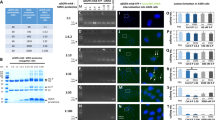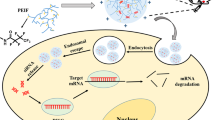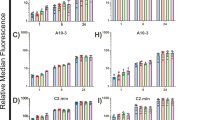Abstract
Technologies that mediate targeted delivery of small interfering RNAs (siRNAs) are needed to improve their therapeutic efficacy and safety. Therefore, we have developed aptamer-siRNA chimeric RNAs capable of cell type–specific binding and delivery of functional siRNAs into cells. The aptamer portion of the chimeras mediates binding to PSMA, a cell-surface receptor overexpressed in prostate cancer cells and tumor vascular endothelium, whereas the siRNA portion targets the expression of survival genes. When applied to cells expressing PSMA, these RNAs are internalized and processed by Dicer, resulting in depletion of the siRNA target proteins and cell death. In contrast, the chimeras do not bind to or function in cells that do not express PSMA. These reagents also specifically inhibit tumor growth and mediate tumor regression in a xenograft model of prostate cancer. These studies demonstrate an approach for targeted delivery of siRNAs with numerous potential applications, including cancer therapeutics.
This is a preview of subscription content, access via your institution
Access options
Subscribe to this journal
Receive 12 print issues and online access
$209.00 per year
only $17.42 per issue
Buy this article
- Purchase on Springer Link
- Instant access to full article PDF
Prices may be subject to local taxes which are calculated during checkout






Similar content being viewed by others
References
Fire, A. et al. Potent and specific genetic interference by double-stranded RNA in Caenorhabditis elegans . Nature 391, 806–811 (1998).
Elbashir, S.M. et al. Duplexes of 21-nucleotide RNAs mediate RNA interference in cultured mammalian cells. Nature 411, 494–498 (2001).
Yano, J. et al. Antitumor activity of small interfering RNA/cationic liposome complex in mouse models of cancer. Clin. Cancer Res. 10, 7721–7726 (2004).
Fountaine, T.M., Wood, M.J. & Wade-Martins, R. Delivering RNA interference to the mammalian brain. Curr. Gene Ther. 5, 399–410 (2005).
Devroe, E. & Silver, P.A. Therapeutic potential of retroviral RNAi vectors. Expert Opin. Biol. Ther. 4, 319–327 (2004).
Anderson, J., Banerjea, A., Planelles, V. & Akkina, R. Potent suppression of HIV type 1 infection by a short hairpin anti-CXCR4 siRNA. AIDS Res. Hum. Retroviruses 19, 699–706 (2003).
Lewis, D.L. & Wolff, J.A. Delivery of siRNA and siRNA expression constructs to adult mammals by hydrodynamic intravascular injection. Methods Enzymol. 392, 336–350 (2005).
Schiffelers, R.M. et al. Cancer siRNA therapy by tumor selective delivery with ligand-targeted sterically stabilized nanoparticle. Nucleic Acids Res. 32, e149 (2004).
Urban-Klein, B. et al. RNAi-mediated gene-targeting through systemic application of polyethylenimine (PEI)-complexed siRNA in vivo. Gene Ther. 12, 461–466 (2005).
Soutschek, J. et al. Therapeutic silencing of an endogenous gene by systemic administration of modified siRNAs. Nature 432, 173–178 (2004).
Lorenz, C. et al. Steroid and lipid conjugates of siRNAs to enhance cellular uptake and gene silencing in liver cells. Bioorg. Med. Chem. Lett. 14, 4975–4977 (2004).
Minakuchi, Y. et al. Atelocollagen-mediated synthetic small interfering RNA delivery for effective gene silencing in vitro and in vivo . Nucleic Acids Res. 32, e109 (2004).
Takeshita, F. et al. Efficient delivery of small interfering RNA to bone-metastatic tumors by using atelocollagen in vivo . Proc. Natl. Acad. Sci. USA 102, 12177–12182 (2005).
Song, E. et al. Antibody mediated in vivo delivery of small interfering RNAs via cell-surface receptors. Nat. Biotechnol. 23, 709–717 (2005).
Hu-lieskovan, S., Heidel, J.D., Bartlett, D.W., Davis, M.E. & Triche, T.J. Sequence-specific knockdown of EWS-FLI1 by targeted, noviral delivery of small interfering RNA inhibits tumor growth in a murine model of metastatic Ewing's sarcoma. Cancer Res. 65, 8984–8992 (2005).
Lupold, S.E., Hicke, B.J., Lin, Y. & Coffey, D.S. Identification and characterization of nuclease-stabilized RNA molecules that bind human prostate cancer cells via the prostate-specific membrane antigen. Cancer Res. 62, 4029–4033 (2002).
Reagan-Shaw, S. & Ahmad, N. Silencing of polo-like kinase (Plk) 1 via siRNA causes induction of apoptosis and impairment of mitosis machinery in human prostate cancer cells: implications for the treatment of prostate cancer. FASEB J. 19, 611–613 (2005).
Takai, N. et al. Polo-like kinases (Plks) and cancer. Oncogene 24, 287–291 (2005).
Eckerdt, F., Yuan, J. & Strebhardt, K. Polo-like kinases and oncogenesis. Oncogene 24, 267–276 (2005).
Cory, S. & Adams, J.M. Killing cancer cells by flipping the Bcl-2/Bax switch. Cancer Cell 8, 5–6 (2005).
Pestourie, C., Tavitian, B. & Duconge, F. Aptamers against extracellular targets for in vivo applications. Biochimie 87, 921–930 (2005).
Nimjee, S.M., Rusconi, C.P. & Sullenger, B.A. Aptamers: an emerging class of therapeutics. Annu. Rev. Med. 56, 555–583 (2005).
Israeli, R.S. et al. Expression of the prostate-specific membrane antigen. Cancer Res. 54, 1807–1811 (1994).
Doi, N. et al. Short-interfering-RNA-mediated gene silencing in mammalian cells requires Dicer and eIF2C translation initiation factors. Curr. Biol. 13, 41–46 (2003).
Murchison, E.P., Partridge, J.F., Tam, O.H., Cheloufi, S. & Hannon, G.J. Characterization of Dicer-deficient murine embryonic stem cells. Proc. Natl. Acad. Sci. USA 102, 12135–12140 (2005).
Kim, D.H. et al. Synthetic dsRNA Dicer substrates enhance RNAi potency and efficacy. Nat. Biotechnol. 23, 222–226 (2005).
Sledz, C.A. et al. Activation of the interferon system by short-interfering RNAs. Nat. Cell Biol. 5, 834–839 (2003).
Kariko, K., Bhuyan, P., Capodici, J. & Weissman, D. Small interfering RNAs mediate sequence-independent gene suppression and induce immune activation by signaling through toll-like receptor 3. J. Immunol. 172, 6545–6549 (2004).
Allerson, C.R. et al. Fully 2'-modified oligonucleotide duplexes with improved in vitro potency and stability compared to unmodified small interfering RNA. J. Med. Chem. 48, 901–904 (2005).
Layzer, J.M. et al. In vivo activity of nuclease-resistant siRNAs. RNA 10, 766–771 (2004).
Cui, Y., Ulrich, H. & Hess, G.P. Selection of 2'-fluoro-modified RNA aptamers for alleviation of cocaine and MK-801 inhibition of the nicotinic acetylcholine receptor. J. Membr. Biol. 202, 137–149 (2004).
Park, K.W. Protamine and protamine reactions. Int. Anesthesiol. Clin. 42, 135–145 (2004).
Shepherd, G.M. Hypersensitivity reactions to drugs: evaluation and management. Mt. Sinai J. Med. 70, 113–125 (2003).
Padilla, R. & Sousa, R. Efficient synthesis of nucleic acids heavily modified with non-canonical ribose 2'-groups using a mutantT7 RNA polymerase (RNAP). Nucleic Acids Res. 27, 1561–1563 (1999).
Myers, J.W., Jones, J.T., Meyer, T. & Ferrell, J.E., Jr. Recombinant Dicer efficiently converts large dsRNAs into siRNAs suitable for gene silencing. Nat. Biotechnol. 21, 324–328 (2003).
Wang, Y., Wang, H., Li, C.Y. & Yuan, F. Effects of rate, volume, and dose of intratumoral infusion on virus dissemination in local gene delivery. Mol. Cancer Ther. 5, 362–366 (2006).
McGuire, S. & Yuan, F. Quantitative analysis of intratumoral infusion of color molecules. Am. J. Physiol. Heart Circ. Physiol. 281, H715–H721 (2001).
Acknowledgements
We thank John Madden and Johannes Vieweg for useful discussions and Mariano Garcia-Blanco and Joseph R. Nevins for useful reagents. B.A.S., E.G., R.E.R., Y.W., K.D.V. and P.H.G. are supported by the National Institutes of Health (NIH). E.R.A. is supported by a postdoctoral training grant from Susan G. Komen Breast Cancer Foundation. J.O.M. is supported by an NIH postdoctoral training grant (5T32CA00911-28). This work was supported by NIH grants 2P01GM059299 and 1U54CA119313 to B.A.S.
Author information
Authors and Affiliations
Contributions
J.O.M. II designed, performed research and wrote manuscript; E.R.A. provided expertise, performed research, and analyzed data; Y.W. performed research; K.D.V. provided expertise; R.E.R. provided useful reagents; E.G. provided useful discussions and analytic tools; B.A.S. suggested chimera idea and provided useful discussions; P.H.G. designed, coordinated and performed research, analyzed data, wrote manuscript.
Note: Supplementary information is available on the Nature Biotechnology website.
Corresponding author
Ethics declarations
Competing interests
The authors declare no competing financial interests.
Supplementary information
Supplementary Fig. 1
Cell-type specific expression of PSMA. (PDF 540 kb)
Supplementary Fig. 2
Relative affinity measurements of A10 and A10 aptamer-siRNA chimeras. (PDF 1048 kb)
Supplementary Fig. 3
Gene silencing mediated by functional siRNAs against Polo-like kinase 1 (Plk1) and Bcl2. (PDF 784 kb)
Supplementary Fig. 4
siRNA-mediated silencing of Dicer. (PDF 552 kb)
Supplementary Fig. 5
Aptamer-siRNA chimeras do not trigger an interferon response. (PDF 607 kb)
Supplementary Fig. 6
Individual tumor curves demonstrating effect of RNA chimeras on growth of LNCaP-derived tumors in mice. (PDF 1083 kb)
Rights and permissions
About this article
Cite this article
McNamara, J., Andrechek, E., Wang, Y. et al. Cell type–specific delivery of siRNAs with aptamer-siRNA chimeras. Nat Biotechnol 24, 1005–1015 (2006). https://doi.org/10.1038/nbt1223
Received:
Accepted:
Published:
Issue Date:
DOI: https://doi.org/10.1038/nbt1223
This article is cited by
-
Inhibition of SARS-CoV-2 infection in human airway epithelium with a xeno-nucleic acid aptamer
Respiratory Research (2023)
-
High-affinity one-step aptamer selection using a non-fouling porous hydrogel
Nature Biotechnology (2023)
-
All that Nobel glitters is not biotech gold
Nature Biotechnology (2023)
-
Design and clinical developments of aptamer-drug conjugates for targeted cancer therapy
Biomaterials Research (2021)
-
Enzymatic ligation of an antibody and arginine 9 peptide for efficient and cell-specific siRNA delivery
Scientific Reports (2021)



